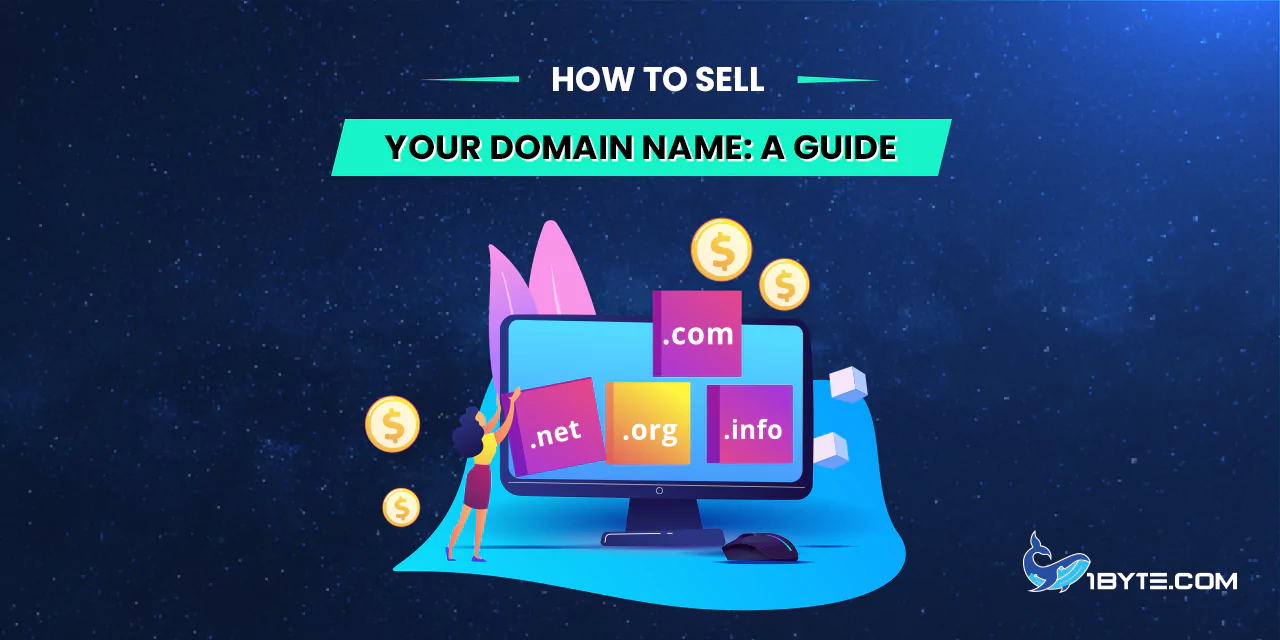It can be a rewarding venture to sell your domain name. It’s all about finding the right buyer and showcasing your domain’s potential. In this comprehensive guide, we’ll show you how to sell your domain name effectively. Whether you’re new to the process or looking to refine your strategy, this 8-step guide has you covered. So, let’s dive into the world of domain name sales and unlock its potential.
5 Instances You Need to Sell Your Domain Name
Why sell your domain name? There are instances when it makes perfect sense. Whether you’re looking to cash in on a valuable asset or simply want to part ways with an unused domain, selling your domain name can be a smart move. In this section, we’ll explore five compelling instances where selling your domain name becomes a strategic decision. So, let’s delve into these scenarios and discover when it’s the right time to sell your domain name.
Unused Domain
An unused domain is a domain name that was purchased for a website but is not being used. This could be because the owner intended to use them for different projects but never got around to it. The issue with unused domain names is the renewal price that needs to be paid each year.
However, there are several ways to make use of these unused domains. For instance, you can create a cheap (or free) but quality affiliate website. You can also sell the domain to different marketplaces such as Afternic or lease it instead of selling. Other options include redirecting the domain to an existing site or social media page, parking the domains for ad revenue, or using the domains for professional emails.
Unlock the potential of your unused domain by exploring these options. Whether it’s generating income, enhancing your online presence, or helping others find the right domain for their needs, there are various avenues to make the most of your unused domain.
Recommended reading: How to Set Up a Gmail Custom Domain: A Step-by-Step Guide
Irrelevant Domain
An irrelevant domain refers to a domain name that is no longer connected with what you are discussing or dealing with. For instance, your current domain name might no longer be relevant to your business or personal brand, and you would like to switch to a new one. In such cases, learning how to sell a domain name can help you make money online from these unused assets or even start a new business.
When assessing a domain, several factors contribute to its value, such as traffic, top-level domains, length, and readability. However, domains that consist of multiple parts and contain unusual words are the least likely to be sold and fetch very low prices.
It’s essential to recognize when your domain has become irrelevant and take the necessary steps to sell it if it no longer serves your goals. Selling an irrelevant domain can not only help you recoup your investment but also open up opportunities for a more fitting online presence.
Profitable Business
Domain trading can indeed be a profitable business model. Many wonder if it’s still worthwhile, given recent developments in the domain market. However, the current situation on the domain market reveals interesting trends.

While .com domains continue to dominate, the availability of attractive domain names with this extension is dwindling. This scarcity has led website owners to explore alternative gTLDs (generic top-level domains). These new gTLDs offer fresh opportunities and creative options for domain traders.
Additionally, the growing global web presence has spawned a variety of domain name registrars, each striving to stand out from the competition. This competition among registrars means more choices for domain traders and potential buyers, ultimately benefiting those involved in domain trading.
Recommended reading: What is an Email Domain: A Closer Look
Financial Needs
Selling a domain name can be a viable solution when you’re in need of quick cash. Unlike stocks and bonds that are easily traded through brokers, selling domain names can present unique challenges.
The process of finding the right buyer often requires patience and persistence, sometimes taking several months or even years. This means that individuals looking to sell domain names should have a lengthy time horizon and be prepared for the possibility of facing a loss.
In situations where you have urgent financial needs, selling a domain name can offer a source of funds. However, it’s essential to approach domain trading with a realistic understanding of the time and effort it may take to find the right buyer and achieve your financial goals.
High Market Demand
The demand for good domain names is consistently high in the United States. With more than 600,000 small businesses opening each year, a significant portion of them establish an online presence with a unique domain name.
A quality domain name can command a substantial price, ranging from $5,000 to $20,000 or even more. This indicates a strong market demand for domain names that resonate with businesses and individuals looking to establish a solid online identity.
As of June 2022, .com domains continue to dominate the internet landscape, constituting 52.8% of all domain registrations. In comparison, other generic top-level domains (gTLDs) like .org make up a much smaller percentage, around 4.4% of all registered domain names.
This high market demand for .com domains and the potential for substantial returns make selling domain names a lucrative opportunity for those with valuable domain assets. Understanding the market dynamics and trends can help domain owners make informed decisions and maximize the value of their assets when they decide to sell.
Recommended reading: Domain Controller vs Active Directory: 7 Key Differences You Should Understand
An 8-Step Guide to Selling Your Domain Name
Selling your domain name can be a profitable endeavor, but navigating the process successfully requires a clear strategy. In this section, we’ll break down the key steps you need to follow, from assessing the value of your domain to negotiating with potential buyers and completing a secure transfer. Whether you’re a seasoned domain trader or a first-time seller, these steps will guide you through the process and ensure you’re well-prepared to sell your domain name effectively. Let’s get started on your journey to sell your domain name for the best possible price.
Determine the Value of Your Domain
Determining the value of your domain is the initial step in the domain selling process. This involves assessing several key factors to arrive at a fair market value.
Consider the domain’s age, as older domains often hold more value. Evaluate its length – shorter, more memorable names tend to be more desirable. Examine the relevance of keywords within the domain, as keywords that align with popular search terms or industries can increase its value.
Brandability is another critical factor. A domain that’s easy to brand and fits well with a business or niche can fetch a higher price. Assess the market demand for similar domains, as this can indicate what potential buyers are willing to pay.
Some domains may have added value due to SEO benefits, such as a history of backlinks or existing web traffic. Additionally, online appraisal tools can provide a rough estimate of a domain’s value, offering a starting point for your pricing strategy.
Price Your Domain
Setting the right price for your domain is the next crucial step in selling it effectively. This task can be somewhat challenging, as it involves finding the delicate balance between not undervaluing your domain and not deterring potential buyers with an overly high price.
It’s paramount to approach pricing with a sense of realism. While premium domains can indeed fetch substantial sums, most domains sell for more modest amounts. Understanding this can help you set an attractive and reasonable price that aligns with market expectations.
Consider factors such as the domain’s age, keyword relevance, branding potential, and market demand when determining your domain’s price. Online appraisal tools and research into similar domain sales can also provide valuable insights into pricing trends.
Put Up a “For Sale” Sign
Informing potential buyers about the availability of your domain is crucial. Putting up a “For Sale” sign on your website is an effective way to convey this message to visitors. This can be as simple as adding a visible banner or a user-friendly pop-up that clearly indicates the domain is up for sale.
Ensure that the sign provides a straightforward means for interested buyers to contact you. Whether it’s through a contact form, email address, or phone number, offering a convenient way for potential buyers to reach out is key to initiating discussions and facilitating the sale process.
By prominently displaying a “For Sale” sign on your website, you increase the visibility of your domain among your existing website visitors and potential buyers, enhancing the chances of a successful sale.
List Your Domain for Sale
To reach a broad audience of potential buyers, consider listing your domain for sale on various online marketplaces. There are several reputable platforms designed for this purpose, including Flippa, BrandBucket, Sedo, Afternic, and us at 1Byte too!
Each of these platforms offers its unique set of benefits and has its own listing process and fee structure. Before listing your domain, it’s essential to familiarize yourself with the specific requirements and costs associated with each platform.
Listing your domain on these marketplaces expands your reach and increases the visibility of your domain to potential buyers actively seeking valuable domain assets. This broader exposure enhances the chances of finding the right buyer and successfully selling your domain.
Sell Your Domain at Auction
Selling your domain at auction is an option offered by some platforms, and it can be an effective strategy. Auctions create a sense of urgency among potential buyers, often resulting in increased competition and the possibility of achieving a higher selling price.

However, it’s important to be aware that selling your domain at auction may come with additional fees. These fees can vary depending on the platform and the type of auction you choose.
Despite the potential for added costs, the auction format can be a powerful way to sell your domain quickly and at a favorable price. It’s a method that leverages buyer enthusiasm and the desire to secure a valuable domain, making it worth considering as part of your domain selling strategy.
Find a Buyer with Outbound Sales
If you have a specific buyer in mind for your domain, such as a business that you believe would greatly benefit from owning it, you can opt for direct outreach. This approach involves actively identifying potential buyers, initiating contact with them, and engaging in negotiations to facilitate the sale.
While this method can be highly targeted and may result in a successful sale, it does require a more significant investment of effort and time on your part. You’ll need to identify potential buyers who would value your domain, craft compelling outreach messages, and be prepared for negotiations.
Direct outreach can be a fruitful strategy when you have a clear vision of the ideal buyer for your domain. It allows you to tailor your approach to the specific needs and interests of potential buyers, potentially leading to a more favorable sale outcome.
Hire a Domain Name Broker
If selling your domain proves challenging or if you prefer to delegate the process, hiring a domain name broker is a viable option. A domain broker can take on various aspects of the sale, from determining the appropriate pricing to actively seeking potential buyers and negotiating the sale.
Notable domain name brokerage services, such as GoDaddy Domain Brokerage and VPN.com, specialize in facilitating domain transactions. They bring expertise and industry knowledge to the table, increasing the likelihood of a successful sale.
By enlisting the services of a domain name broker, you can offload the complexities of the sale process, ensuring that your domain is in the hands of professionals who can maximize its value and help you secure a favorable deal.
Use an Escrow Service
Once you’ve successfully found a buyer and agreed on a price for your domain, it’s essential to ensure a secure and smooth transaction process. To do this, it’s highly recommended to utilize an escrow service.
An escrow service serves as an impartial third party in the domain sale, holding the funds securely until all terms of the sale agreement are met. This safeguards the interests of both the seller and the buyer by guaranteeing that the domain is transferred correctly and all necessary conditions are fulfilled before the funds are released.
The use of an escrow service adds an extra layer of security and trust to the transaction, reducing the risk of fraud or disputes. It’s a critical step in the domain selling process that ensures a fair and successful exchange of assets.
FURTHER READING: |
1.What is the .net Domain? Understanding the Basics |
2.How to Get a .gov Domain: Step-by-Step Guide |
3. A Closer Look at What the .co Domain Is |
Leverage 1Byte’s strong cloud computing expertise to boost your business in a big way
1Byte provides complete domain registration services that include dedicated support staff, educated customer care, reasonable costs, as well as a domain price search tool.
Elevate your online security with 1Byte's SSL Service. Unparalleled protection, seamless integration, and peace of mind for your digital journey.
No matter the cloud server package you pick, you can rely on 1Byte for dependability, privacy, security, and a stress-free experience that is essential for successful businesses.
Choosing us as your shared hosting provider allows you to get excellent value for your money while enjoying the same level of quality and functionality as more expensive options.
Through highly flexible programs, 1Byte's cutting-edge cloud hosting gives great solutions to small and medium-sized businesses faster, more securely, and at reduced costs.
Stay ahead of the competition with 1Byte's innovative WordPress hosting services. Our feature-rich plans and unmatched reliability ensure your website stands out and delivers an unforgettable user experience.
As an official AWS Partner, one of our primary responsibilities is to assist businesses in modernizing their operations and make the most of their journeys to the cloud with AWS.
Conclusion
Selling your domain name can be a rewarding endeavor when approached with careful planning and strategy. This comprehensive 8-step guide has outlined the essentials needed to successfully sell your domain name.
From determining the value of your domain to setting a competitive price, marketing it effectively, and choosing the right sales platforms or brokers, each step plays a pivotal role in securing a favorable sale.
Remember to leverage your domain’s unique qualities, engage potential buyers through various channels, and consider all available options, including auctions and direct outreach. When you find the right buyer and agree on terms, using an escrow service ensures a secure and trustworthy transaction.
Selling your domain name is not only a potential source of profit but also an opportunity to see your valuable asset in the hands of someone who can make the most of it. With the guidance provided in this guide, you’re well-equipped to navigate the domain selling process and achieve success in selling your domain name.

